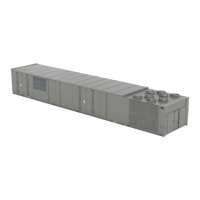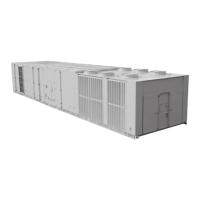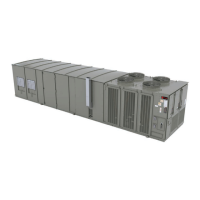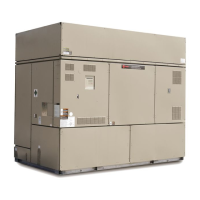74
RT-SVX073A-EN
“in-control” when supply fan and return fan are proven.
Supply fan operation always starts before return fan.
Return Plenum Pressure Sensor Proving
The return plenum static pressure sensor is proven in the
return fan startup sequence. An initial return plenum static
pressure sensor value is recorded, and then supply fan
starts and holds at the configured minimum fan speed. The
return plenum static pressure sensor is proven by a +/-0.03
IWC delta within 1 minute. Once supply fan and return
plenum static pressure sensor are proven, the return fan
starts and operation proven before releasing to return fan
speed control. If the return plenum pressure sensor is not
proven within one minute of supply fan starting, the return
fan operation starts, and an additional two-minute timer is
initiated. The return plenum static pressure sensor must
demonstrate a +/-0.03 IWC delta within the two minutes.
Otherwise, a Return Plenum Static Pressure Sensor
diagnostic is generated.
Return Fan Control
When return fan is released to algorithm control, an initial
return plenum static pressure setpoint is calculated based
on the relief damper status. If the relief damper is closed
(0%), the setpoint is -0.05 IWC, otherwise a calculated
target is determined. From this initialization the control
calculates a soft-load target setpoint.
As increasingly greater supply fan and outdoor air is
delivered to the space, the relief damper will open to relief
air the space under normal conditions. The greater air
volume being supplied and relieved will increase the target
return plenum static pressure target. The return plenum
static pressure target setpoint is managed between Return
Plenum Static Pressure Minimum Setpoint and Return
Plenum Static Pressure Maximum Setpoint.
Return Fan Control Limits
The following limits apply to return fan control and are only
active when the return fan is “in-control”. The limits are
described lowest to highest priority order:
1. Return Fan Minimum Capacity Limit (Statitrac control
active)
2. Return Plenum Static Pressure High Limit
3. Return Fan Critical Low Space Pressure Limit (Statitrac
control active)
Return Fan Minimum Capacity Limit
Return Fan Minimum Capacity Limit permits the return
plenum static pressure to increase above the Return
Plenum Static Pressure Control Target setpoint and Return
Plenum Static Pressure Maximum Setpoint to ensure there
is sufficient return plenum pressure for proper space static
pressure control.
Return Plenum Static Pressure High Limit
If return plenum static pressure approaches the Return
Plenum Static Pressure High Limit, the return fan speed is
limited by Return Plenum Static Pressure High Limit control
to prevent potential equipment cabinet damage.
Return Fan Space Pressure Critical Low
Limit
Return fan space pressure critical low limit applies when
Statitrac (space static pressure control) is active. Normally
return fan speed is controlled to maintain the Return
Plenum Static Pressure Target. If a critically low space
static pressure occurs, the relief damper control and return
fan speed control is utilized in sequence to allow space
static pressure recovery. When space static pressure
approaches Space Static Pressure Low Limit Setpoint,
Relief Damper Space Static Pressure Low Limit
incrementally closes the relief damper. When the relief
damper command is 0%, Return Fan Space Static
Pressure Critical Low Limit incrementally reduces the
return fan to minimum speed.
Discharge Air Temperature Control
Discharge Air Temperature Control uses available heating
and cooling capacity to deliver the required temperature at
the discharge of the unit. A discharge air temperature
sensor is required for operation.
In cooling modes, the control uses cooling sources to
deliver air temperature as required by the Discharge Air
Cooling Setpoint. In heating modes, the control uses heat
sources to deliver air temperature as required by the
Discharge Air Heating Setpoint. Primary heat is never used
in conjunction with mechanical cooling.
Multi Zone-VAV - Discharge Temperature
Units
These unit types provide Discharge Air Temperature
Control in all heat, cool, and occupancy modes of
operation. The typical operating mode is Cooling delivering
conditioned air to multiple zones of a building. Multi Zone-
VAV units have duct work to supply VAV terminal units. The
VAV units modulate to control space comfort.
These units also change over to provide heat (when
installed). A building automation system or VAV Box Relay
Output can be used when the heat source requires full
airflow. See Heat Types for more information. A valid space
temperature input must be provided to perform heating
modes such as Daytime Warm Up and Morning Warm Up
(when enabled).
Supply Air Tempering
Supply Air Tempering is a function of discharge air control
Cool mode when DX cooling is off and the outdoor air
damper is at minimum position. This function is typically
required when outdoor air intake percentage is high and
the outdoor air temperature is low. If discharge air
temperature falls below the Discharge Air Cooling Setpoint,
the control will temper (warm up) the discharge air by
initiating heating capacity. Cool – Tempering is displayed
on the user interface Operating Mode screen when this
function is active. The control will transition back to normal
Unit Startup

